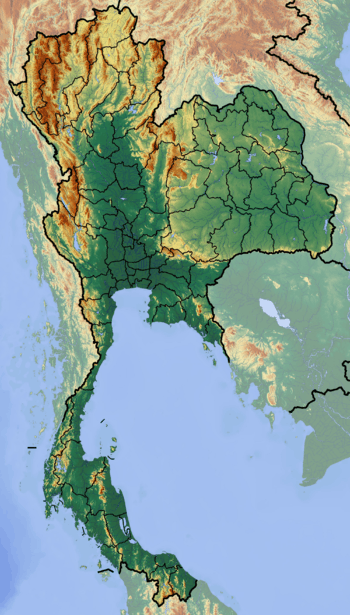Sao Khua Formation
The Sao Khua Formation is a middle member of the Khorat Group. It consists of an alteration of pale red to yellowish-gray, fine to medium-grained sandstone and grayish-reddish brown siltstone and clay. Rare pale red to light gray conglomerates, containing carbonate pebbles, are also characteristic of this formation. This geological formation in Thailand, dates to the Early Cretaceous age.
| Sao Khua Formation Stratigraphic range: Barremian ~129–125 Ma | |
|---|---|
| Type | Geological formation |
| Unit of | Khorat Group |
| Underlies | Phu Phan Formation |
| Overlies | Phra Wihan Formation |
| Thickness | ~120 m (390 ft) |
| Lithology | |
| Primary | Sandstone, conglomerate |
| Other | Siltstone, claystone |
| Location | |
| Coordinates | 16.7°N 102.3°E |
| Approximate paleocoordinates | 14.3°N 112.4°E |
| Region | Indochina |
| Country | |
| Extent | Khorat Plateau |
| Type section | |
| Named by | Ward & Bunnag |
| Year defined | 1964 |
 Sao Khua Formation (Thailand) | |
Dinosaur remains are among the fossils that have been recovered from the formation.[1]
Vertebrate paleofauna
Dinosaurs
- Siamosaurus - spinosaurid theropod, described in 1986 - "Isolated teeth."[2] - Spinosauridae Incertae Sedis
- Siamotyrannus - Carnosaur [3]theropod, described in 1996 - "Pelvis, dorsal, sacral, and caudal vertebrae."[4]
- Phuwiangosaurus - titanosaurian sauropod, described in 1994 - "Partial skeletons, juvenile - adult."[5]
- Kinnareemimus - ornithomimosaurian theropod, described in 2009
- Phuwiangvenator - megaraptoran theropod, described in 2019[6]
- Vayuraptor - coelurosaurian theropod, described in 2019[6]
- Theropoda indet. (= compsognathid indet.)
- Sauropoda indet. 1 e 2
gollark: oh dear.
gollark: That seems like a weird mix of responsibilities.
gollark: I'm not actually in university. I'm doing A-levels next year. Which still makes me *technically* a "student".
gollark: Technically, nothing now? It's my holidays.
gollark: I don't actually work for money. I'm a student.
See also
- List of dinosaur-bearing rock formations
References
- Weishampel, David B; et al. (2004). "Dinosaur distribution (Early Cretaceous, Asia)." In: Weishampel, David B.; Dodson, Peter; and Osmólska, Halszka (eds.): The Dinosauria, 2nd, Berkeley: University of California Press. Pp. 563-570. ISBN 0-520-24209-2.
- "Table 4.1," in Weishampel, et al. (2004). Page 78.
- Holtz, Thomas R. et al. (2004). "Basal Tetanurae." In: Weishampel, David B.; Dodson, Peter; and Osmólska, Halszka (eds.): The Dinosauria, 2nd, Berkeley: University of California Press. Pp. 101. ISBN 0-520-24209-2.
- "Table 4.1," in Weishampel, et al. (2004). Page 74.
- "Table 13.1," in Weishampel, et al. (2004). Page 268.
- Adun Samathi; Phornphen Chanthasit; P. Martin Sander (2019). "Two new basal coelurosaurian theropod dinosaurs from the Lower Cretaceous Sao Khua Formation of Thailand". Acta Palaeontologica Polonica. 64. doi:10.4202/app.00540.2018.
This article is issued from Wikipedia. The text is licensed under Creative Commons - Attribution - Sharealike. Additional terms may apply for the media files.